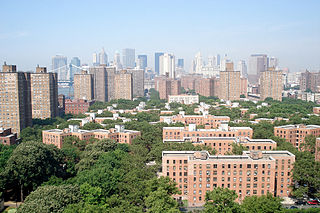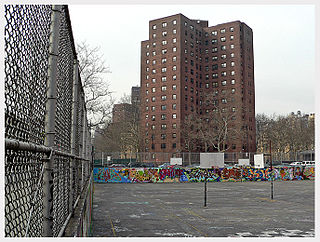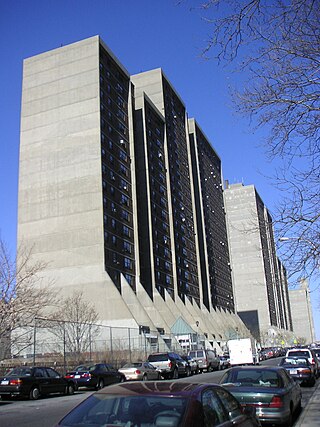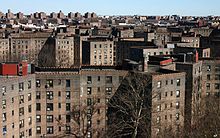
The Harlem River Houses is a New York City Housing Authority public housing complex between 151st Street, 153rd Street, Macombs Place, and the Harlem River Drive in the Harlem neighborhood of Manhattan in New York City. The complex, which covers 9 acres (3.6 ha), was built in 1936-37 and opened in October 1937 – one of the first two housing projects in the city funded by the Federal government – with the goal of providing quality housing for working-class African Americans. It has 574 apartments.

Senator Robert F. Wagner Houses, also known as Triborough Houses, is a public housing development in the East Harlem neighborhood of Manhattan, in New York City and is administered by the New York City Housing Authority. It is located east of Second Avenue in the northeast corner of Manhattan, consists of fourteen 16-story buildings and eight 7-story buildings, a total of 22 buildings. It has 5,290 residents who live in 2,162 apartments. The complex occupies 26.91 acres (10.89 ha). It cost $30,926,000 to construct.

The Robert Fulton Houses is a housing project located in the Chelsea neighborhood of Manhattan in New York City, owned and operated by the New York City Housing Authority (NYCHA). The 6.27-acre (2.54 ha) site is located between West 16th and 19th Streets and bounded by Ninth and Tenth Avenues. The project consists of 945 apartments in eleven buildings; three of the developments are 25 stories, while the others are 6 stories high.
The Prospect Plaza Houses was a 4.53-acre (18,300 m2) complex owned by the New York City Housing Authority (NYCHA) in the Ocean Hill section of Brooklyn and was bordered by St. Marks and Sterling Place, Howard and Saratoga Avenues. It was the first NYCHA development to be completely demolished.

Breukelen Houses, also known as Breukelen or Brookline Projects, is a large housing complex maintained in Canarsie, Brooklyn, by the New York City Housing Authority (NYCHA). Its main office is located at 618 East 108th Street, Brooklyn, NY 11236. It is bounded by Flatlands Avenue, East 103rd Street, Williams Avenue and Stanley Avenue. The community sits on 64.98 acres (26.30 ha) and consists of 1,595 apartment units inside 30 structures, all of which are either three or seven stories high. As of March 2008 the population was estimated to be 4,038.

St. Nicholas Houses or "Saint Nick," is a public housing project in Central Harlem, in the borough of Manhattan, New York City and are managed by the New York City Housing Authority (NYCHA). The project is located between Adam Clayton Powell Jr. Boulevard and Frederick Douglass Boulevard, spanning a superblock from 127th Street to 131st Street. The project consists of thirteen 14-story buildings containing 1,523 apartment units.

The John Haynes Holmes Towers is a public housing project for low income residents of the Yorkville section of the Upper East Side located just south of the neighborhood's northern limit at 96th Street, in New York City, New York, United States. The neighboring Isaacs Houses and the Holmes Towers border East Harlem, which has the second highest concentration of public housing in the United States. The two public housing buildings, designed by Architects Eggers and Higgins, were completed in 1969, are 25 stories tall and contain 537 apartments. The project is located between 92nd and 93rd Streets from 1st Avenue to York Avenue and the FDR Drive.

Bernard M. Baruch Houses, or Baruch Houses, is a public housing development built by the New York City Housing Authority (NYCHA) on the Lower East Side of Manhattan. Baruch Houses is bounded by Franklin D. Roosevelt East River Drive to the east, E. Houston Street to the north, Columbia Street to the west, and Delancey Street to the south. The complex, the largest NYCHA development in Manhattan, occupies 27.64 acres (111,900 m2), of which buildings cover 13.4%, a percentage similar to that of most "tower in the park" project designs. It has 2,194 apartments, which house an estimated 5,397 people. These apartments are distributed throughout 17 buildings. Baruch Houses I is seven stories tall, Baruch Houses XI, XIII, and XV are thirteen stories tall, and the rest are fourteen stories tall. Combined, these buildings have 2.9 million square feet (270,000 m2).

Mayor Fiorello H. LaGuardia Houses, also known as LaGuardia Houses, is a public housing development built and maintained by the New York City Housing Authority (NYCHA) on the Lower East Side of Manhattan. Mayor Fiorello H. LaGuardia Houses is composed of thirteen buildings, all of which are sixteen stories tall. The buildings have 1,093 apartments and house approximately 2,596 people. The complex occupies 10.96 acres (4.44 ha), and is bordered by Madison Street to the north, Montgomery Street to the east, Cherry Street to the south, and Rutgers Street to the west. LaGuardia Houses Addition is a sixteen-story tower for elderly people at the corner of Jefferson Street and Cherry Street.

Rutgers Houses, also known as Henry Rutgers Houses, is a public housing development built and maintained by the New York City Housing Authority (NYCHA) on the Lower East Side of Manhattan. Rutgers Houses is composed of five 20 story buildings on 5.22 acres (21,100 m2), with 721 apartments housing approximately 1,675 people. The complex is bordered by Madison Street to the north, Rutgers Street to the east, Cherry Street to the south, and Pike Street to the west.

Carver Houses, or George Washington Carver Houses, is a public housing development built and maintained by the New York City Housing Authority (NYCHA) in Spanish Harlem, a neighborhood of Manhattan.
Governor DeWitt Clinton Houses, also known as DeWitt Clinton Houses or Clinton Houses, is a public housing development built and maintained by the New York City Housing Authority (NYCHA) in the Spanish Harlem neighborhood of Manhattan. Clinton Houses is composed of six buildings, resting on a non-continuous campus with an area of 5.6 acres (23,000 m2). Five of those (I-V) are 18 stories high, and another (VI) is nine stories high. The six buildings have a total of 749 apartments, which house 1,823 people. Clinton Houses occupies the two blocks that are bordered by East 110th Street to the north, Lexington Avenue to the east, Park Avenue to the west, and East 108th Street to the south. It also occupies the western half of the two blocks that are bordered by East 106th Street to the north, Lexington Avenue to the east, Park Avenue to the west, and East 104th Street to the south, with the exception of a small part along East 106th Street.

Morrisania Air Rights is a New York City Housing Authority (NYCHA) public housing project in Melrose and Morrisania, Bronx, consisting of three buildings, 19, 23, and 29 stories tall. There are 843 apartments housing some 1,952 residents. It was designed by the architectural firm The Eggers Partnership also known as Eggers & Higgins.

The Elliott-Chelsea Houses is a combined housing project of the New York City Housing Authority (NYCHA), located between West 25th and 27th Streets and Ninth and Tenth Avenues in the Chelsea neighborhood of Manhattan, New York City. It consists of two contiguous projects which were originally separate but have been combined for administrative purposes: the John Lovejoy Elliott Houses, named after the founder of the Hudson Guild, has four 11- and 12-story buildings which accommodate over 1400 residents in 589 apartments. The Chelsea Houses has over 1,000 residents in 426 apartments within two 21-story buildings.

The Farragut Houses is a public housing project located in the downtown neighborhood of northwestern Brooklyn, New York City, bordering the Brooklyn Navy Yard. Farragut Houses is a property of New York City Housing Authority (NYCHA). The houses contain 3,272 residents who reside in ten buildings that are each 13 to 14 stories high.
The Forest Houses are a housing project in Morrisania, Bronx. The project consists of fifteen buildings, 9, 10 and 14-stories tall with 1,350 apartment units. It covers a 17.72-acre expanse, and is bordered by East 163rd and East 166th Streets, and Trinity and Tinton Avenues. It is owned and managed by New York City Housing Authority (NYCHA).
Kingsborough Houses-Kingsborough Extension, also known as Kingsborough Houses, is a 15.97-acre housing project in the Crown Heights neighborhood of Brooklyn in New York City. It is bordered by Ralph and Rochester Avenues, and Pacific and Bergen Streets. The project consists of 16, six-story buildings with 1,148 apartment units. It is owned and managed by New York City Housing Authority.
The Louis Heaton Pink Houses or Pink Houses are a housing project in New York City that were established in the East New York neighborhood in Brooklyn in 1959. It consists of 22 eight-storey buildings with 1,500 apartment units over a 31.1-acre expanse, bordered by Crescent Street, Linden Boulevard, Elderts Lane and Stanley Avenue. It is owned and managed by New York City Housing Authority (NYCHA).
Low Houses, or Seth Low Projects, is a public housing complex built and operated by the New York City Housing Authority (NYCHA) and located in Brownsville, Brooklyn. The development is named after Seth Low (1850–1916). As NYC Mayor, he attacked the existence of unsanitary tenements. Low Houses has four buildings between 17 and 18 stories tall, each with 535 apartments. Completed December 31, 1967, 5.89-acres. The Low Houses is considered one of Brooklyn's toughest projects and have been known for shootings and gang violence throughout the years.







































